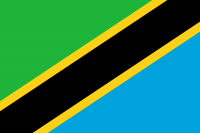Tanzania

The United Republic of Tanzania includes the Indian Ocean islands of Pemba and Zanzibar and the mainland territory, covering a total area of 1,0219,090 km², and is located on the east coast of Africa between the great lakes of the African Rift Valley system in the central part of the continent and the Indian Ocean. Tanzania has a common border with Kenya and Uganda to the north; Rwanda, Burundi and the Democratic Republic of Congo to the west; and Zambia, Malawi and Mozambique to the south. The country encompasses a variety of physical features; from a narrow coastal belt with tropical beaches it rises to an extensive plateau covered by savannah and bush at an elevation of about 1,000 metres above sea level. The plateau region is fringed by narrow belts of forested highlands, which includes the snow-capped Mount Kilimanjaro (5,897 metres above sea level), the highest mountain in Africa. Lakes Tanganyika, Nyasa and Rukwa partly occupy the floor of the Great Rift Valley system. At 358 metres below sea level, the floor of Lake Tanganyika is Africa’s lowest point.
Tanzania is a tropical country that includes four main climatic zones: the hot, humid coastal plains; the hot, arid zone of the central plateau; high, moist lake regions; and temperate highlands. The climate is governed by two monsoons. The north east monsoon from December to March brings the year’s hottest temperatures, and when the winds shift to the south from March to May, they bring the heavy intermittent rains of the south west monsoon, which extends from June to September bringing relatively cool, dry weather. A smaller wet season occurs in November and December. Rainfall varies from an annual average of 1,250mm in the wettest 3 % of the land area, the south eastern slopes of the great volcanoes, to below 600mm in the central area of the country.
The total population of Tanzania is estimated at 50,586,000 (latest census). There are over 120 ethnic groups, each with its own language or dialect. Indigenous Tanzanians make up 99 % of the population, while other ethnic groups include Asians, Europeans and Arabs. KiSwahili is the official, universally-spoken language in Tanzania. English, also an official language, is the language of commerce. The capital has been Dar es Salaam since 1974, and is the largest city with a population of about 2,500,000, and serves as the main port, dominant industrial centre, and the focus of government and commerce. Elections are held every five years, with the first multiparty election being held in November 1995. The President is the Head of State for a maximum of two terms in office.
Tanzania is heavily dependent on agriculture, which accounts for 46 % of Gross Domestic Product (GDP), provides 75 % of exports and employs 80 % of the total workforce. Agriculture is the backbone of the Tanzanian economy, with principal cash crops including cotton lint, cashew nuts, tobacco, coffee and tea. The country has diverse mineral deposits, including precious minerals such as gold, diamonds, tanzanite and rubies as well as industrial minerals such as iron, tin, copper, nickel, cobalt, lead, limestone, titanium, vanadium, uranium, phosphate and gypsum. It also has deposits of coal and natural gas.
Tanzania is considered to be one of the premier tourism destinations in Africa. The country has bountiful natural resources, including extensive tracts of wilderness and a rich diversity of scenery. There are 12 National Parks, including the famous Serengeti, 34 Game Reserves, and 38 Game Controlled Areas. The prime tourist attractions include Mount Kilamanjaro, Zanzibar’s historic Stone Town, the Olduvai Gorge archaeological site and clean white sand beaches fringed by palm trees.

